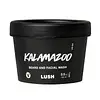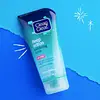What's inside
What's inside
 Key Ingredients
Key Ingredients

No key ingredients
 Benefits
Benefits

 Concerns
Concerns

 Ingredients Side-by-side
Ingredients Side-by-side

Water
Skin ConditioningStearic Acid
CleansingSodium Cocoamphoacetate
CleansingPEG-10 Glyceryl Stearate
EmulsifyingGlycerin
HumectantTriethanolamine
BufferingCetearyl Alcohol
EmollientPrunus Amygdalus Dulcis Oil
Skin ConditioningPrunus Armeniaca Kernel Oil
MaskingCucumis Sativus Juice
EmollientParfum
MaskingSimmondsia Chinensis Seed Oil
EmollientTheobroma Grandiflorum Seed Butter
Skin ConditioningCitrus Aurantifolia Peel
Skin ConditioningCitrus Aurantium Sinensis Fiber
Emulsion StabilisingBoswellia Carterii Oil
MaskingGeraniol
PerfumingLimonene
PerfumingLinalool
PerfumingHydroxycitronellal
PerfumingMethylparaben
PreservativeWater, Stearic Acid, Sodium Cocoamphoacetate, PEG-10 Glyceryl Stearate, Glycerin, Triethanolamine, Cetearyl Alcohol, Prunus Amygdalus Dulcis Oil, Prunus Armeniaca Kernel Oil, Cucumis Sativus Juice, Parfum, Simmondsia Chinensis Seed Oil, Theobroma Grandiflorum Seed Butter, Citrus Aurantifolia Peel, Citrus Aurantium Sinensis Fiber, Boswellia Carterii Oil, Geraniol, Limonene, Linalool, Hydroxycitronellal, Methylparaben
Water
Skin ConditioningMethyl Gluceth-20
HumectantLauryl Glucoside
CleansingPolyethylene
AbrasiveDisodium Lauroamphodiacetate
CleansingSodium Laureth Sulfate
CleansingPEG-80 Sorbitan Laurate
Acrylates/C10-30 Alkyl Acrylate Crosspolymer
Emulsion StabilisingDimethicone PEG-8 Meadowfoamate
EmollientParfum
MaskingMicrocrystalline Wax
Emulsion StabilisingMethylparaben
PreservativeSodium Hydroxide
BufferingMenthol
MaskingDMDM Hydantoin
PreservativePanthenol
Skin ConditioningDisodium EDTA
Polyquaternium-7
Citric Acid
BufferingSodium Benzotriazolyl Butylphenol Sulfonate
UV AbsorberBlue 1 Lake
Cosmetic ColorantCI 19140
Cosmetic ColorantCI 73360
Cosmetic ColorantTalc
AbrasiveUltramarines
Water, Methyl Gluceth-20, Lauryl Glucoside, Polyethylene, Disodium Lauroamphodiacetate, Sodium Laureth Sulfate, PEG-80 Sorbitan Laurate, Acrylates/C10-30 Alkyl Acrylate Crosspolymer, Dimethicone PEG-8 Meadowfoamate, Parfum, Microcrystalline Wax, Methylparaben, Sodium Hydroxide, Menthol, DMDM Hydantoin, Panthenol, Disodium EDTA, Polyquaternium-7, Citric Acid, Sodium Benzotriazolyl Butylphenol Sulfonate, Blue 1 Lake, CI 19140, CI 73360, Talc, Ultramarines
Ingredients Explained
These ingredients are found in both products.
Ingredients higher up in an ingredient list are typically present in a larger amount.
Methylparaben is a preservative and is a paraben. It is used to prevent the growth of fungus, mold, and other harmful bacteria. Parabens are chemicals used as preservatives in both cosmetics and food.
Methylparaben can be synthetically created. It can also be found naturally in some fruits, such as blueberries.
Oftentimes, Methylparaben is combined with other parabens to help increase the shelf life.
The safety of Methylparaben is currently being studied. While ongoing studies are looking into the safety of parabens, the results have been very mixed. Some studies have not found Methylparaben to be harmful.
Learn more about MethylparabenParfum is a catch-all term for an ingredient or more that is used to give a scent to products.
Also called "fragrance", this ingredient can be a blend of hundreds of chemicals or plant oils. This means every product with "fragrance" or "parfum" in the ingredients list is a different mixture.
For instance, Habanolide is a proprietary trade name for a specific aroma chemical. When used as a fragrance ingredient in cosmetics, most aroma chemicals fall under the broad labeling category of “FRAGRANCE” or “PARFUM” according to EU and US regulations.
The term 'parfum' or 'fragrance' is not regulated in many countries. In many cases, it is up to the brand to define this term.
For instance, many brands choose to label themselves as "fragrance-free" because they are not using synthetic fragrances. However, their products may still contain ingredients such as essential oils that are considered a fragrance by INCI standards.
One example is Calendula flower extract. Calendula is an essential oil that still imparts a scent or 'fragrance'.
Depending on the blend, the ingredients in the mixture can cause allergies and sensitivities on the skin. Some ingredients that are known EU allergens include linalool and citronellol.
Parfum can also be used to mask or cover an unpleasant scent.
The bottom line is: not all fragrances/parfum/ingredients are created equally. If you are worried about fragrances, we recommend taking a closer look at an ingredient. And of course, we always recommend speaking with a professional.
Learn more about ParfumWater. It's the most common cosmetic ingredient of all. You'll usually see it at the top of ingredient lists, meaning that it makes up the largest part of the product.
So why is it so popular? Water most often acts as a solvent - this means that it helps dissolve other ingredients into the formulation.
You'll also recognize water as that liquid we all need to stay alive. If you see this, drink a glass of water. Stay hydrated!
Learn more about Water